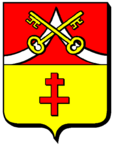Achen
| Achen | ||
|---|---|---|

|
|
|
| region | Grand Est | |
| Department | Moselle | |
| Arrondissement | Sarreguemines | |
| Canton | Bitche | |
| Community association | Pays de Bitche | |
| Coordinates | 49 ° 3 ' N , 7 ° 11' E | |
| height | 225–336 m | |
| surface | 12.12 km 2 | |
| Residents | 1,011 (January 1, 2017) | |
| Population density | 83 inhabitants / km 2 | |
| Post Code | 57412 | |
| INSEE code | 57006 | |
 View of Achen |
||
Achen is a French commune with 1011 inhabitants (as of January 1, 2017) in the Moselle department in the Grand Est region (until 2015 Lorraine ). The French community of Achen must not be confused with the German city of Aachen in North Rhine-Westphalia .
geography
Achen located at the junction of the singing Linger stream in the Ache , on the edge of Bitscher country where the Lorraine plateau for Saartal with the Lorraine brazier drops. The district consists mainly of arable land, 310 hectares are (fruit) meadows, only about 75 hectares are forest. The remnants of the Maginot Line still take up some area. On the Achenbach there are five mills spread across the district. In the north, Achen borders on Wiesviller and Wœlfling-lès-Sarreguemines , in the northeast and east on Gros-Réderching , in the south-east on Bining , in the south on Etting , in the south-west and west on Kalhausen and in the north-west on Wittring .
history
Achen was first mentioned in 1199 under the name Aqua and has had its current name since 1553. It belonged to Zweibrücken-Bitsch , then for a time to the rule of Lützelstein and returned to Zweibrücken-Bitsch after being temporarily occupied by Lorraine. Over the centuries, various other rulers and the Sturzelbronn Abbey asserted rights in Achen before Lorraine finally conquered the place in 1572. The year of the plague in 1621 and the Thirty Years War led to the extensive desertification of Achens, which was previously one of the largest communities in the Bitscher Land . It was not until 1661 that life returned - not least because of immigrants. From 1790 to 2015, Achen was now part of the Rohrbach canton . On September 1, 1939, the residents of Achens were evacuated to the Charente department and the mayor's office was temporarily housed in Condac . The population was able to return after 13 months.
On December 7, 1941, large parts of Achens, including the historic bridge, were destroyed in a heavy bombardment. The Allies liberated Achen on 8 December 1944 while, but it came in the wake of an attack on 3 January 1945 again to a German partial occupation of the town.
Nothing reminds of Pfaffenthal , which was formerly located in today's Achen district .
Population development
| 1962 | 1968 | 1975 | 1982 | 1990 | 1999 | 2007 | 2017 |
|---|---|---|---|---|---|---|---|
| 857 | 875 | 883 | 896 | 929 | 938 | 996 | 1011 |
Culture and sights
- The Church of St. Peter was built in 1728.
- The fulling mill , mentioned in the mill letter of Count von Zweibrücken-Bitsch in 1546, was in ruins from around 1661. Restoration was approved in 1733. It has been owned by the Gross family since 1867, but they no longer operate the mill.
- The Neumühle from 1612, destroyed in the Thirty Years War and then rebuilt, is now used as a residential building.
- The oligmill from 1729 changed hands frequently. It was in operation well into the 20th century. - The gall mill from around 1725 is also no longer in operation. Your name comes from the Swiss immigrant family Gall.
- In the valley of the Ache there are few traces of the barracks of the 153rd French Infantry Regiment stationed here until the Second World War .
- Remnants of the Maginot Line .
Economy and Infrastructure
Before the Second World War, smallholder agriculture shaped the working world. The fragmentation into more than 10,000 parcels was a major obstacle. Many mills use the water of the Ache. After 1945, until its demise, mining in the Lorraine coal basin was the main employer for most of the working people. Today there are many cross- border commuters in the industrial plants of Zweibrücken and Pirmasens . The main shopping city is Saargemünd , and Rohrbach is also for daily needs . Local small businesses and handicrafts, which used to be abundant, hardly exist anymore. About a dozen farmers are still farming.
literature
- Blaise Illig, Monograph d'Achen, 1928.
Web links
- Achen on bitscherland.fr (French)
- Former website of Mairie ( memento of November 19, 2008 in the Internet Archive ) (French)

